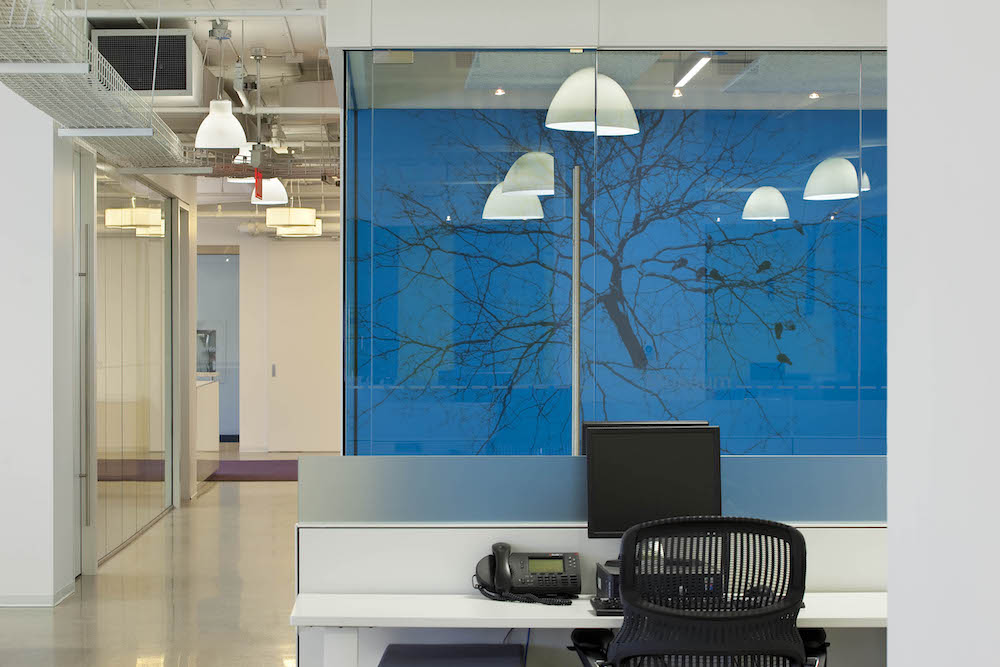Bartlett & Associates‘ Inger Bartlett shares ideas for designing healthy and calming workplaces that take cues from the natural world.

We all know that spending time in nature is good for us. At the height of the COVID-19 pandemic, people living in cities flocked to public parks in search of trees, sunlight and fresh air. Not surprisingly, outdoor activities like bird watching and gardening exploded in popularity in response to shelter-in-place orders.
It’s no wonder people sought comfort in the great outdoors: one study tied spending at least 120 minutes per week in nature to good health and wellbeing. In Japan, forest bathing – the mindful practice of taking in the sights, sounds and smells of the forest – has been shown to mitigate stress and burnout.
Unfortunately, Americans spend at least 90% of their time indoors. With restrictions easing and more workers being called back to their desks, a huge chunk of that time will once again be spent at the office – far away from the calming effects of nature.
It’s up to designers to find creative ways to invite the natural world – along with its myriad benefits – indoors. For decades, our studio has been guided by biophilia: the idea that humans naturally seek to connect with nature. Biophilic design has been shown to reduce stress, improve cognitive functioning, boost productivity, and support creativity and wellbeing at the office.
Here are some ways biophilic design can uplift workers as we transition back to the office.

Think outside the box
When it comes to post-COVID office design, we should move away from straight lines and right angles. Many returning workers will find sitting at rigid benching grids jarring after answering emails from the comfort of bed. Workstations modeled after naturally occurring shapes can inspire movement and out-of-the-box thinking, all while creating surprising interior views that keep the workday interesting. At the offices of tech firm Volaris, which overlooks a conservation area, we gestured to the surrounding forest by using 120-degree desks. These organically-shaped workstations spark creativity and spontaneous conversation among staff – something we’ve all been missing as a result of WFH policies.

Create a diverse ecosystem
The days of one-size-fits-all workplaces are behind us. Rather than identical rows of desks, offices should mirror the diversity of natural ecosystems. Employees given a choice of workstations – from cozy alcoves to standing desks to communal tables – feel a greater sense of control over their environment. Heterogenous workplaces also do a better job of accommodating different personality types. Cushioned booth seating or high-backed lounge chairs give introverts a sense of enclosure and privacy, while also serving to dampen noise. Extroverts might prefer to brainstorm around a long table placed at the heart of the action, or retreat to ancillary meeting rooms for focused discussions. The more spaces we carve out for individual working styles, the happier and more effective staff become.
Find the right location
The pandemic resulted in the biggest shake-up in commercial real estate in recent memory. Many companies that gave up their office space in the shift from in-person to remote work will be looking for new outposts to call home. This presents a wonderful opportunity to prioritize proximity to parks, walking trails or waterfronts in the search for the perfect address. Research shows that employees favored with views of nature felt more relaxed, focused and productive throughout the day than those whose desks faced a blank wall. Having greenspace nearby encourages staff to be more active: for example, to go for an invigorating midday walk rather than eating lunch at their desks.

Nature as metaphor
As much as we’d all love to work nestled in a woodland, the reality is that most of us will spend the workday high-up in a glass tower. When moving the office to a greener locale isn’t an option, gesturing to nature through the use of vegetation, nature-inspired artwork and organic materials is crucial. At B|A, we’ve started to use the expression ‘design metaphor’ to refer to design elements that indirectly reference another context – for example a stone slab for nature, a water element for the sea, or timber slats for a forest. Deploying these elements in the workplace creates moments of respite from artificial environments.

Let there be light
Artificial lighting has been shown to interrupt the body’s circadian rhythm, making it difficult to fall asleep after a long workday. A lack of sleep (and coffee) can wreak havoc on productivity at the office. Luckily, contemporary offices are often flooded with natural light thanks to the expansive glazing used in commercial buildings. Even still, it might be difficult for light to penetrate into the core of an open plan workspace. One solution is to provide a range of luminaires – from pot lights to dimmable pendants to task lighting – to give employees greater control over brightness. Smart lightbulbs can be programmed to emit warmer hues in contrast to the harsh blue lighting often associated with office work, promoting a sense of calm.

